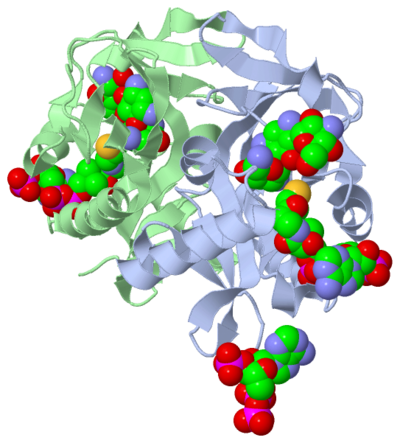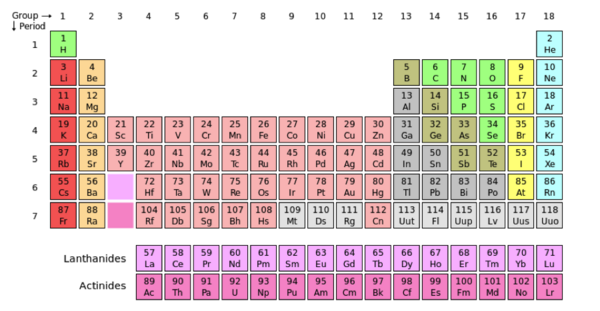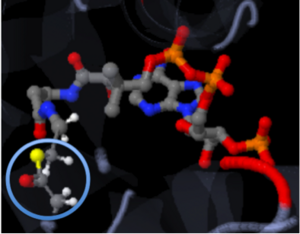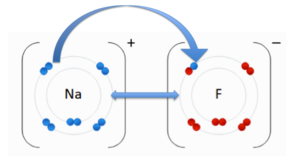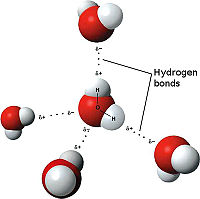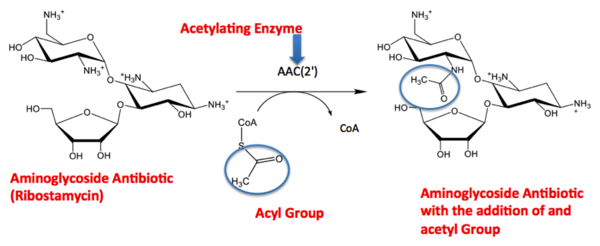Tutorial:Basic Chemistry Topics
From Proteopedia
| Line 36: | Line 36: | ||
7. Be able to classify amino acids and understand what the classification represents | 7. Be able to classify amino acids and understand what the classification represents | ||
| + | ='''Periodic table'''= | ||
| + | |||
| + | [[Image:Periodic table.png| thumb | center | 600px |<ref name="substrate" />]] | ||
| + | |||
| + | |||
| + | An atom is the smallest unit of matter. Protons, neutron, and electrons, make up the composition of an atom providing its physical features. The common physical features of atoms are used to organize them in the periodic table. Electrons are negatively charged particles that surround the atom’s nucleolus. Protons are positively charged particles and neutrons are uncharged. Both neutrons and protons are located in the central part of the atom known as the nucleus. | ||
| + | |||
| + | The image above displays Oxygen (O) in its periodic box. The atomic mass of oxygen is 8, centered above the single-letter abbreviation of Oxygen. “8” represents the number of protons in the atom’s nucleolus. The atomic number is also used to arrange elements in the periodic table, notice the increasing value of protons in the atoms from left to right. The atomic mass of an element is centered under the single-letter abbreviation of the atom and represents the total weight of the atom, in this case oxygen has an atomic mass of ~16. The total weight of an atom is the sum of the atoms protons, neutrons and electrons. | ||
| + | ='''Amino acids'''= | ||
='''Types of Bonds'''= | ='''Types of Bonds'''= | ||
| Line 169: | Line 178: | ||
| - | ='''Amino Acids'''= | ||
| - | |||
| - | [[Image:Periodic table.png| thumb | center | 600px |<ref name="substrate" />]] | ||
| - | |||
| - | Amino acids are the building blocks of proteins. There are 20 common amino acids. The basic structure of an amino acid is an amine group (-NH2), a carboxylic acid group (-COOH) and a functional group specific to each amino acid. The functional group determines how the amino acid is categorized. They are categorized as polar, non-polar, acidic or basic. Amino acids are commonly referred to using their three-letter abbreviation. I have provided the three-letter abbreviations along side the amino acids in their category list. | ||
| - | |||
| - | An amino acid is considered polar when the charges electronegativity between atoms in the functional group are extremely different. For example, water is considered polar. This is because the electronegativity of oxygen is extremely high and the electronegativity of hydrogen is extremely low. The opposing electronegativity is making water polar. In contrast, non-polar is when the electronegativity of the atoms in the functional group are similar. An amino acid is considered polar when it has an acidic functional group, such as a carboxylic acid (pH~1-6). In correlation, a basic amino acid has a basic functional group, such as an amine group (pH~8-14). An amino acid is neutral when it has a functional group that displays a pH close to physiological pH (~7). A list of the most common amino acids and their categories are as follows for your reference. | ||
| - | |||
| - | '''Neutral Amino Acids:''' | ||
| - | Alanine (ala) | ||
| - | Asparagine (asn) | ||
| - | Cysteine (cyc) | ||
| - | Glutamine (gln) | ||
| - | Glycine (gly) | ||
| - | Isoleucine (ile) | ||
| - | Leucine (leu) | ||
| - | Methionine (met) | ||
| - | Phenylalanine (phe) | ||
| - | Proline (pro) | ||
| - | Serine (ser) | ||
| - | Threonine (thr) | ||
| - | Tryptophan (trp) | ||
| - | Tyrosine (tyr) | ||
| - | Valine (val) | ||
| - | |||
| - | '''Acidic amino acids:''' | ||
| - | Aspartic acid (asp) Glutamic acid (glu) | ||
| - | |||
| - | '''Basic Amino acids:''' | ||
| - | Arginine (arg)Histidine (his) Lysine (lys) | ||
| - | |||
| - | '''Polar Amino acids:''' | ||
| - | Arginine (arg) Asparagine (asn) Aspartic acid (asp)Cysteine (cyc) Glutamic Acid (glu) Glutamine (gln) Histidine (his) Lysine (lys) Serine (ser) Threonine (thr) Tryptophan (trp) Tyrosine (tyr) | ||
| - | |||
| - | '''Non-polar amino acids:''' | ||
| - | Alanine (ala) Glycine (gly) Isoleucine (ile) Leucine (leu) Methionine (met) Phenylalanine (phe) Proline (pro) Valine (val) | ||
| - | |||
| - | There are 8 different amino acids present in the research article main compound. | ||
| - | |||
| - | |||
| - | |||
| - | ==CoA Amino Acids== | ||
| - | |||
| - | Coenzyme A (CoA) has seven amino acids bound to it. The amino acids consist of two arginine, one glycine, and four valine’s. | ||
| - | Arginine is a basic amino acid and is a nonessential A nonessential amino acid is an amino acid that can be synthesized by the body, so it is not essential that you obtain the amino acid form another source. Glycine is a non-polar, basic amino acid. It is also the smallest common amino acid. The functional group attached is hydrogen. Valine is also categorized as a nonpolar, basic amino acid. Valine is nonpolar and basic because the functional group consists of two methyl groups. | ||
| - | |||
| - | |||
| - | CoA and Arg124 | ||
| - | |||
| - | CoA and Gly92 | ||
| - | |||
| - | CoA and Val96 | ||
| - | |||
| - | CoA and Val86 | ||
| - | |||
| - | CoA and Val94 | ||
| - | |||
| - | CoA and Val84 | ||
| - | |||
| - | |||
| - | ==Tobramycin Amino Acids== | ||
| - | |||
| - | Tobramycin has four amino acids bound to it. There are two aspartic acid, a serine, and a tryptophan. | ||
| - | |||
| - | Asp35 | ||
| - | |||
| - | Trp181 | ||
| - | |||
| - | Ser117 | ||
| - | |||
| - | Asp152 | ||
| - | ==PAP Amino Acids== | ||
| - | PAP has four amino acids bound to it. There are two histidine’s and a tryptophan. | ||
| - | His54 | ||
| - | Trp90 | ||
| - | His55 | ||
Revision as of 22:47, 30 November 2012
Purpose of the Tutorial
- This tutorial is intended as a beneficial learning/teaching aid for an entry-level chemistry college student with some basic chemistry knowledge. Applying general chemistry to a research article will allow the students to see the impact they can have on the research world in the future by applying their knowledge. Various general chemistry concepts are explained using a research article as an example.
Summary: Scientific Research Article
The molecule to left is from the article "Aminoglycoside 2'-N-acetyltransferase from Mycobacterium tuberculosis-Complex with Coenzyme A and Tobramycin" published in Nature Structural Biology.[2]. The study focused on aminoglycoside 2’- N- acetyltransferase (AAC (2’)- Ic), an enzyme. This enzyme is a protein that speeds the rate of the reaction it catalyzes.
This study determined the structure of AAC (2’)-Ic from Mycobacterium tuberculosis, a pathogen. This pathogen is a microorganism that causes tuberculosis (TB), which typically affects the lungs, but can affect other parts of the body as well. The specific structure/protein fold of AAC (2’)-Ic places it in the GCN5-related N-acetyltransferase (GNAT) superfamily. The GNAT superfamily is a group of enzymes that are similar in structure. The protein fold is important because it determines the function of the compound.[2]
The GNAT family is a group of acetylating enzymes. Acetylation is the addition of CH3CO functional group onto a compound. Although the physiological function of AAC(2’)-Ic is not certain, the discovery of the GNAT fold allowed researchers to classify AAC (2’)-Ic as an acetylating enzyme. Mycothiol is catalyzed by AAC (2’)-Ic to acetylate the aminoglycoside antibiotic, Tobramycin. When this occurs the aminoglycoside antibiotic becomes inactive. The basis of this study is important because when pathogens become resistant or inactive to commonly used antibiotics, an infection that used to be easily cured can now become severe and life threatening.[2]
| |||||||||||
References
- ↑ Vetting, M. W., et al. "Aminoglycoside 2'-N-acetyltransferase from Mycobacterium tuberculosis-Complex with Coenzyme A and Tobramycin." RCSB Protien DataBase. N.p., 28 Aug.2002. Web. 13 July 2011. http://www.rcsb.org/pdb/explore/explore.do?structureId=1M4D
- ↑ 2.0 2.1 2.2 2.3 2.4 Vetting, Matthew W., et al. "Aminoglycoside 2'-N-acetyltransferase from Mycobacterium tuberculosis-Complex with Coenzyme A and Tobramycin."Nature Structural Biology 9.9 (2002): 653-58. Print.
- ↑ 3.0 3.1 3.2 Wikipedia. Wikipedia, 4 Nov. 2012. Web. 7 Nov. 2012. <http://en.wikipedia.org/wiki/Enzyme_substrate_(biology)
- ↑ User:Cepheus. "Periodic Table." Wikipedia. N.p., 26 Feb. 2007. Web. 26 Nov. 2012. <http://en.wikipedia.org/wiki/File:Periodic_table.svg>.
- ↑ . "File:NaF.gif." Wikipedia. Wikipedia, 17 June 2011. Web. 31 Oct. 2012.<http://en.wikipedia.org/wiki/File:NaF.gif.
- ↑ Maňas, Michal, trans. "File:3D model hydrogen bonds in water.jpg." Wikimedia Commons. Wikimedia Commons, 3 Dec. 2007. Web. 31 Oct. 2012 <http://commons.wikimedia.org/wiki/File:3D_model_hydrogen_bonds_in_water.jpg.
- ↑ "Tobramycin." Wikipedia. Wikipedia, n.d. Web. 26 Nov. 2012.<http://en.wikipedia.org/wiki/Tobramycin>.
